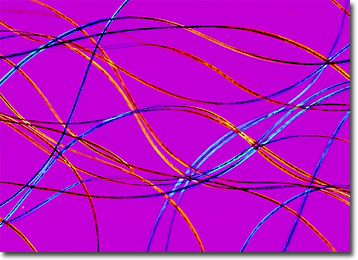Polarized Light Microscopy Digital Image Gallery
Beaver Hair
The beaver is the second largest rodent in the world, growing up to four feet long including their prominent tails and weighing up to 60 pounds. In prehistoric times, beavers were even more impressive in size, the bodies of some North American species achieving masses similar to those of modern black bears.

View a second image of Beaver Hair
Beavers are well known for their amazing engineering capabilities. Through the use of their unusually strong teeth, these aquatic rodents can fell small trees, which they use along with collected sticks to construct lodges and dams. The trees and sticks are held together in these constructions through the use of mud, which the beavers apply with their paws and their characteristic flat, paddle-shaped tails. Beavers also build burrows in banks and canals that aid them in moving the wood they have collected to the proper location. Such activities of the primarily nocturnal animals are instinctive, and those in captivity continue to carry them out although they serve no practical purpose.
Though beavers were once abundant in the Northern Hemisphere, extensive hunting of the animals for their fur and musk glands caused them to be eradicated from much of their range by the mid-1800s. The liquid exuded by the musk glands, called castoreum, was sought for medicinal use and perfumes, while the thick, lush fur was highly valued for hats and other apparel. Indeed, beaver was such a fundamental commodity in colonial America that their skins became a unit of measure, traders using them as a sort of money that could be used to purchase a certain number of other goods. Despite the continued demand for beaver fur and other products, however, in recent years, the aquatic animals have regained much of their former range due to limitations placed on hunting and reintroduction efforts.
